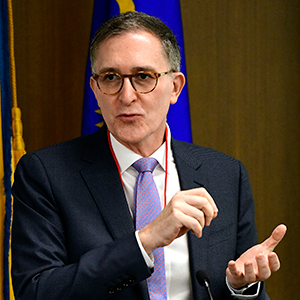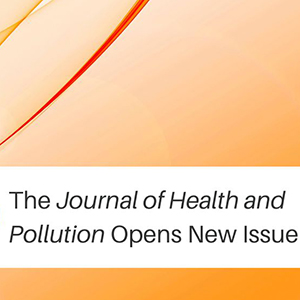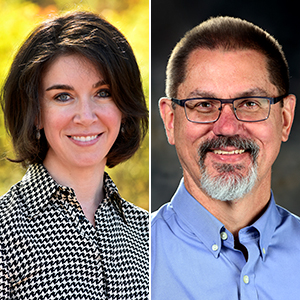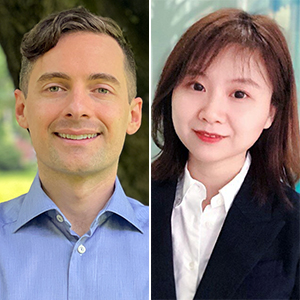Considering both genetic factors and environmental influences is vital for understanding health outcomes and disease prevention. Focusing on these elements separately paints an incomplete picture, according to Christine Ladd-Acosta, Ph.D., an epidemiologist at the Johns Hopkins Bloomberg School of Public Health.
During her April 30 Keystone Science Lecture, Ladd-Acosta outlined why and how to consider environmental exposure data alongside genetic information to help researchers achieve the following goals.
- Identify modifiable risk factors to promote prevention.
- Uncover biological mechanisms to develop new treatments.
- Find predictive biomarkers to improve diagnosis, prognosis, and treatment response.
- Provide population-level perspective to inform public health interventions.
Ladd-Acosta currently leads several federally funded research projects to investigate how genes and the environment contribute to health and disease, particularly neurodevelopmental conditions.
“Dr. Ladd-Acosta’s research program tackles fundamental questions about the joint effects of genes and environment on autism and other health outcomes by harnessing the power of many large national and international epidemiology studies,” said Cindy Lawler, Ph.D., who hosted the lecture and leads the Genes, Environment, and Health Branch at NIEHS.
Real-world examples
Ladd-Acosta used several case studies to illustrate the value of combining genetic and environmental data. She began with the case of phenylketonuria, a disease that prevents the breakdown of the amino acid phenylalanine. The buildup of phenylalanine in the blood and brain damages the nervous system. Though caused by a rare genetic mutation, the condition is also in part environmental because symptoms only appear if mutation carriers eat food containing phenylalanine.

“Using this information, we can modify individual diet to prevent the symptoms from appearing,” said Ladd-Acosta. “Public health initiatives that include universal genetic screening shortly after birth could help identify infants with specific variants that require treatment. Considering both genetic and environmental factors is crucial at a population-wide level.”
Ladd-Acosta also noted that gene-environment interactions are crucial for understanding biologic processes involved in health outcomes. As an example, she called attention to the fact that certain mutations on the CCR5 gene — which can confer resistance to HIV — have helped to shed light on the biological mechanism underlying this condition, as well as possible avenues for therapeutic prevention and treatment.
“Scientists studying this gene variant found that carriers display a change in the structure of their cell membranes, which can prevent HIV from binding,” said Ladd-Acosta. “This mechanism is now targeted for therapeutics, providing a really clear case of how studying the relationship between genes and environment can have a positive impact on health.”
Suggestions for gene-environment studies
In addition to emphasizing the value of this line of research, Ladd-Acosta also provided a set of suggestions for environmental health researchers to consider as part of their studies. These recommendations include practical tips, as well as knowledge gaps, that need to be addressed.
- Study Design: Develop larger datasets that include genetic, environmental, and outcome information derived from multiple different studies.
- Statistical Methods: Consider which statistical model is most appropriate for a particular hypothesis and whether tools such as machine learning could help.
- Genomic Analyses: Conduct more gene-wide association studies to connect exposures, outcomes, and biological pathways, including studies of how genes influence exposure response and how maternal genetics influences exposure during pregnancy.
- Exposure Measures: Carry out more gene-environment chemical exposure studies, with particular attention to mixtures of toxic chemicals.
Ladd-Acosta stressed that more time, attention, and resources should be devoted to gene-environment research. She would also like to see increased efforts to diversify the types of participants included in studies and the range of topics being addressed.
“From 2008 to 2022, there was a major increase in gene-environment studies, but most focused on European individuals and very few other racial or ethnic categories,” Ladd-Acosta said. “There is also very little research on the physical and built environment, including exposures that NIEHS is really interested in, such as toxic chemicals and pollutants.”
To address this gap, Ladd-Acosta is co-leading an NIEHS-supported project to shed new light on gene-environment interaction in autism spectrum disorder (ASD) across a network of 18 sites and multiple studies. The Combining advances in Genomics and Environmental science to accelerate Actionable Research (GEARs) in ASD Network is creating the infrastructure and processes to harmonize large-scale data on both genetics and the environment using novel statistical methods to improve understanding of the causes and consequences of ASD.
(Ben Richardson, Ph.D., is a Presidential Management Fellow in the NIEHS Office of Communications and Public Liaison.)









